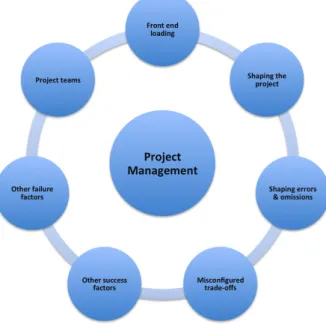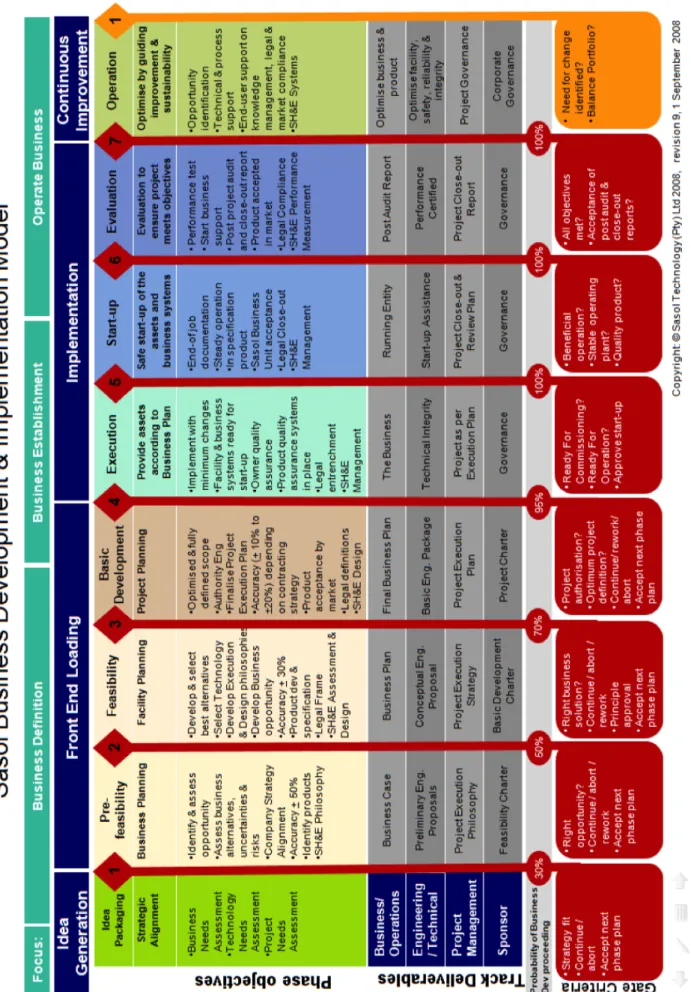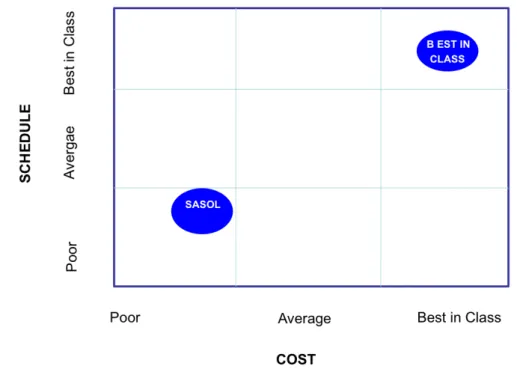Sasol Technology's project management department has a need to understand the underlying reasons for the success or failure of various projects. The report concludes with specific focus areas and recommendations for Sasol Technology's project management department.
Introduction & Background
Project Aim & Objectives
Problem Definition
Project Scope
Investigation
A validation can take place with project managers at Sasol who answer questions about their respective failed projects; this information will be the basis for highlighting areas where and why Sasol's projects are failing.
Literature Review
Introduction
It is important to look for commonalities between different sources of information and connect them to Sasol's needs in a way that benefits them in the long run. As noted in the problem statement Sasol loses approximately 20-25% of all project capital expenditure due to failed projects, the ultimate goal is to reduce this figure for the good of the business.
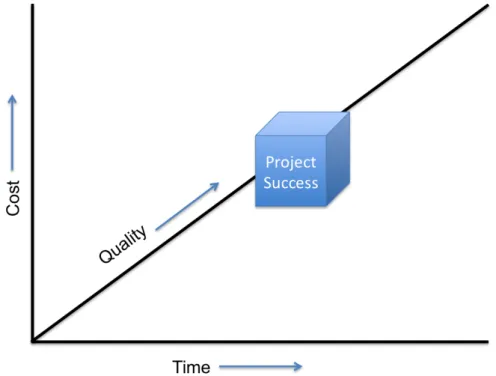
Front End Loading
It is basically the life cycle phases of the project and it is composed of phases and gates. Regardless of the underlying source of the possible opportunity, the project is initially no more than that, an opportunity.
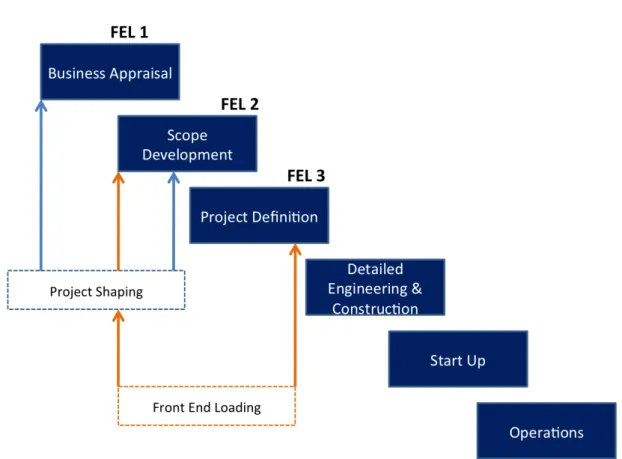
Shaping
The second step in the formation process is to assess the potential value of the project. The formation process is all about assigning the projects value to various or stakeholders.
Shaping Omissions & Errors
In terms of trade-offs, the target objectives and outputs are important because together they determine the expected direct economic value of the project. Sometimes project goals are set so conservatively that the value of the project is severely compromised right from the start.
Misconfigured project trade-offs
One of the key deliverables in the design process is gathering expected results, including how much the project will cost, when it will be finished, and how much product it will reliably produce over time. Most of the time, trade-off functions are uncertain and vary for different projects and at different times. As with sacrificing quality for cost, this result is almost always unintended because it significantly reduces the value of the asset.
One is that the front-end loading schedule is so rushed that the scope is not appropriate and the project suffers from operational problems. But the most common problem is that some of the technical background data that is essential for proper design is never fully developed. The drive for unattainable speed in megaproject development and execution is a symptom of serious pathology in the modern industrial enterprise.
Critical success factors of projects
After the shaping strategy is complete, project development can begin, but as mentioned earlier, most project problems occur before a project has even started. Bridging the gap will help restore a spirit of collaboration not only in the development and execution of the projects, but more generally in the way the company operated. The business goals for the projects determine how the business goals around generating comparative advantage are reflected in the project.
One of the big questions facing industrial sponsors going forward is how to staff the many projects they want to do. The required investment in front-end loading (FEL) is about 3 to 5 percent of the total capital cost and about 30 to 40 percent of the total project time. The projects that did not achieve a good FEL were usually NPV negative. The step-by-step FEL process is a core business process and companies should insist that it is done.

Factors leading to the failure of projects
It is necessary to know the basic data for the process, if it is new or acquired from the licensor. The consequences are if the basic data is not well known, there are errors in it or some data is omitted. Baseline data must be complete and available before scope or FEL2 development begins.
Baseline data that arrives late affects the engineering work, but if it arrives after the scope has been developed, it can cause major cost overruns and design delays, and is a major distraction for the project team. If there are changes to the underlying data after the FEL3 phase, this may result in a complete loss of the asset. Essentially, when the basic data needs of a project are not understood in the early or FEL1 stages of a project, at the beginning of the design process, it becomes too late to obtain quality data when the need arises.
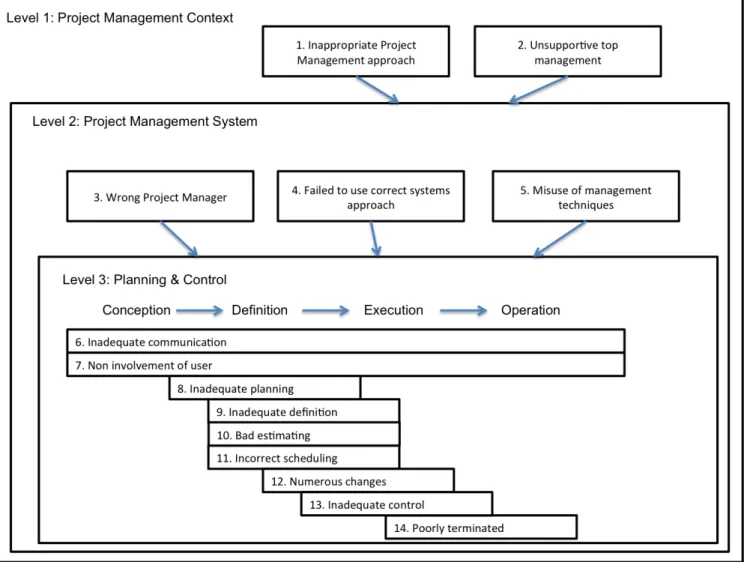
The importance of project teams
Although project teams are constantly changing, turnover in leadership during the project can still be disruptive and damaging. Most damaging is the departure of the project director at any time between FEL2 and the completion of the project. The leader must be trusted by his team and motivate them to achieve their goals within the project scope.
And finally, the most indispensable aspect of the project management process is getting the front end right. Between these stages are the gateways where reviews are made on the economic, business and technical aspects of the project. If the above-mentioned aspects are acceptable at any stage, the project is allowed to continue, if not the project must be stopped and re-evaluated or the problems corrected.
Conclusion
It is also clear that there are areas in project management, which work hand in hand with each other to achieve the best possible outcomes. These projects are managed by skilled and qualified people, so there are underlying complications that plague these projects. It is clear that it is necessary to address the fundamental problems and not to try to solve the problems arising from them.
In a research that follows some failed Sasol projects, we will analyze what issues and problems caused their failures.
Methods & Tools
This research will not be focused on creating new theory, but rather on conducting a new focused analysis on an existing problem and testing assumptions that have already been made. The focused analysis will be done by means of a set of clearly articulated questions in project critical success areas as derived from the literature review. So, in summary, Sasol will be compared against project management best practices as researched in the literature review.
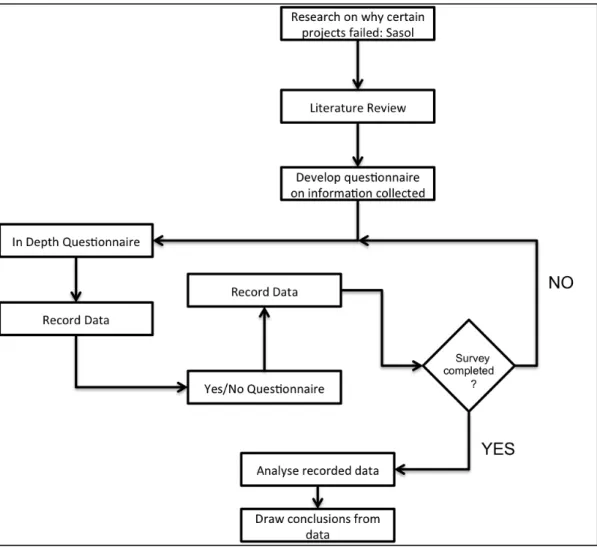
Research
Survey 1 – Based on basic project management principles
These questions were designed based on project management best practices that were addressed in the literature review. A set of relevant questions is designed for each category and based on the result of the analysis; any deficiencies in critical areas will be highlighted. Is there sufficient communication between owners and contractors regarding project objectives?
Survey 2 (Yes/No) – Based on project management critical success factors
Deliverables & Validation
Each project will be evaluated according to the survey in Appendix A, and the results will be drawn and presented as indicated in figure 11 above. More specifically, particular attention will be drawn to categories that indicate a lack of compliance in specific areas. These specific focus areas will form the basis for improvement in the current Sasol project management department, system or procedures.
Finally, as suggested in the project proposal, clear recommendations will be made so that Sasol can improve its project management process.
Results
Introduction
The research was conducted on a small sample of 14 projects that had failed or were failing because they were over budget, over schedule or under budget. The research was conducted by asking the project managers to complete surveys to identify where and why projects failed. Since each project is unique, with distinct requirements, responses are expected to vary.
The plan was to find a trend in failed Sasol projects and consequently identify areas where improvements could be made within the project management system or process.
Results obtained from the surveys
Analysis of results
These questions are categorized into the 6 sections as mentioned earlier. In the analysis of the yes/no survey, more than 40% selected no for the questions marked in red. It is also important to mention that while the other areas were not prominent with specific bottlenecks, there are opportunities for improvement in these areas.
Conclusion
The aim at the beginning of the report was to research and investigate a sample of failed projects at Sasol to understand the areas and sections in the project management process that could be improved or improved in the future. The questionnaires were then given to project managers who were part of the project management department. The sections that need the most attention are the cupboards in the center.
Looking at the project specific radar screens, it is clear that some projects are doing better than others and the analysis shows very clearly that projects deficient in any of the 6 critical areas generally fail. Radar charts marked with a star are the projects that had problems due to the areas mentioned above. The larger sample can be viewed and intricate project management details can be explored to understand the full scope of the issues.

Recommendations
Areas in need of improvement
Since project development is an integral part of a global engineering company like Sasol, optimizing and adapting the project management process to ensure that multi-million dollar projects are ultimately successful is a critical process. The research brought to light a basic understanding of the field and the many areas that determine the critical success factors of the project. After completing the research, a list of areas in the field of project management was highlighted.
These areas formed the basis of the questionnaires, which were subsequently designed to understand where and why projects failed, based on the key areas examined in the literature review. The project manager was also involved or responsible for projects that experienced some kind of failure. With the feedback from the questionnaires, the areas with the most negative reviews were therefore the areas highlighted for further analysis. The results after a general analysis from study 1 are represented in the radar chart below.
Sasol's project management team can work on these areas to improve the eventual success rate of projects. Clear recommendations will be provided in the section that follows in order for Sasol to move forward with the implementation of their small projects.
Project Manager Feedback
Project Manager Feedback
